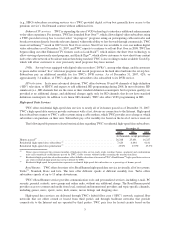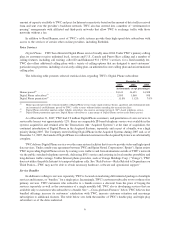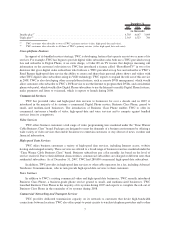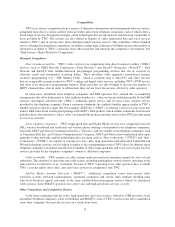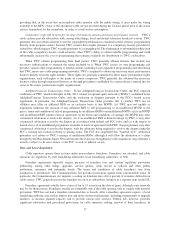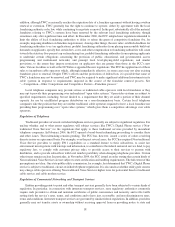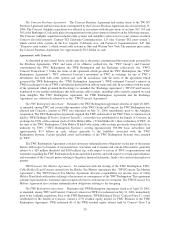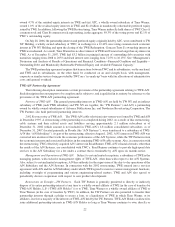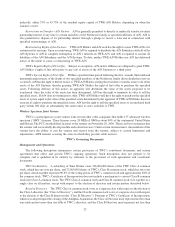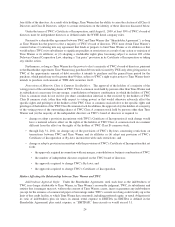Time Warner Cable 2007 Annual Report Download - page 20
Download and view the complete annual report
Please find page 20 of the 2007 Time Warner Cable annual report below. You can navigate through the pages in the report by either clicking on the pages listed below, or by using the keyword search tool below to find specific information within the annual report.In connection with certain changes in TWC’s programming line-up, the Communications Act and FCC
regulations also require TWC to give various kinds of advance notice. Under certain circumstances, TWC must give
as much as 30 days’ advance notice to subscribers, programmers and franchising authorities. Under certain
circumstances, notice may have to be given in the form of bill inserts, on-screen announcements and/or newspaper
advertisements. Giving notice can be expensive and, given long lead times, may limit TWC’s ability to implement
programming changes quickly. DBS operators and other non-cable programming distributors are not subject to
analogous duties.
In November 2007, the FCC also adopted a requirement that cable operators submit to the agency information
concerning the number of homes that their systems pass and information concerning their subscribers. The agency
intends to use this information to determine whether the so-called “70/70” test has been met, which may give the
FCC authority to promulgate certain additional regulations covering cable operators if it is shown that cable systems
with 36 or more activated channels are available to 70 percent of households within the United States and that
70 percent of those households subscribe to such systems.
High-speed Internet access. From time to time, industry groups, telephone companies and Internet service
providers (“ISPs”) have sought local, state and federal regulations that would require cable operators to sell capacity
on their systems to ISPs under a common carrier regulatory scheme. Cable operators have successfully challenged
regulations requiring this “forced access,” although courts that have considered these cases have employed varying
legal rationales in rejecting these regulations.
In 2002, the FCC released an order in which it determined that cable-modem service constitutes an
“information service” rather than a “cable service” or a “telecommunications service,” as those terms are used
in the Communications Act. That determination was sustained by the U.S. Supreme Court. According to the FCC,
an “information service” classification may permit but does not require it to impose “multiple ISP” requirements. In
2002, the FCC initiated a rulemaking proceeding to consider whether it may and should do so and whether local
franchising authorities should be permitted to do so. As of December 31, 2007, this rulemaking proceeding was still
pending. As noted above, in 2005, the FCC adopted a Net Neutrality Policy Statement intended to offer guidance on
its approach to the Internet and broadband access. Among other things, the Policy Statement stated that consumers
are entitled to competition among network, service and content providers, and to access the lawful content and
services of their choice, subject to the needs of law enforcement. The FCC may in the future adopt specific
regulations to implement the Policy Statement.
Ownership limitations. There are various rules prohibiting joint ownership of cable systems and other kinds
of communications facilities. Local telephone companies generally may not acquire more than a small equity
interest in an existing cable system in the telephone company’s service area, and cable operators generally may not
acquire more than a small equity interest in a local telephone company providing service within the cable operator’s
franchise area. In addition, cable operators may not have more than a small interest in multipoint microwave
distribution service (“MMDS”) facilities or SMATV systems in their service areas. Finally, the FCC has been
exploring whether it should prohibit cable operators from holding ownership interests in satellite operators.
The Communications Act also required the FCC to adopt “reasonable limits” on the number of subscribers a
cable operator may reach through systems in which it holds an ownership interest. In September 1993, the FCC
adopted a rule that was later amended to prohibit any cable operator from serving more than 30% of all cable,
satellite and other multi-channel subscribers nationwide. The Communications Act also required the FCC to adopt
“reasonable limits” on the number of channels that cable operators may fill with programming services in which
they hold an ownership interest. In September 1993, the FCC imposed a limit of 40% of a cable operator’s first 75
activated channels. In March 2001, a federal appeals court struck down both limits and remanded the issue to the
FCC for further review. The FCC initiated a rulemaking in 2001 to consider adopting a new horizontal ownership
limit and announced a follow-on proceeding to consider the issue anew. In December 2007, the FCC adopted a rule
to prohibit any cable operator from serving more than 30% of all cable, satellite and other multi-channel subscribers
nationwide and launched a further Notice of Proposed Rulemaking seeking comment on vertical ownership limits
and cable attribution rules.
Pole attachment regulation. The Communications Act requires that utilities provide cable systems and
telecommunications carriers with non-discriminatory access to any pole, conduit or right-of-way controlled by
15


